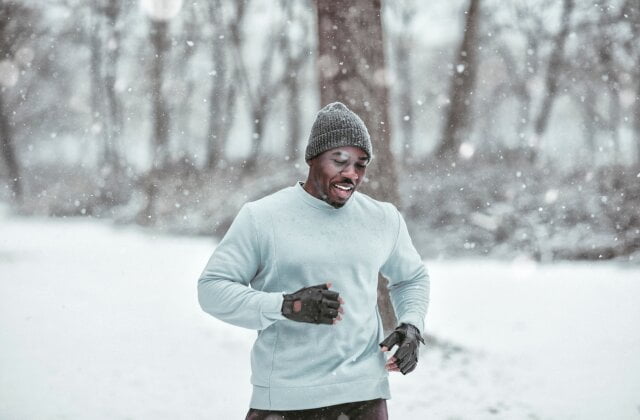Winter workouts are important during the cold season, but some things must be considered. The human body operates in a narrow temperature range which is not an obstacle to performing different sports during winter. Thanks to thermoregulation, our body can persist in various environmental conditions. Some would say that a temperature below 5°C may be considered low, however, exercise, body fat and suitable clothing can neutralize the effects of coldness. It is worth mentioning that the cardiovascular state and overall fitness heavily influence performance in a cold environment (1).
Of course, staying active during winter can be tricky. We all like to cuddle up in a blanket and watch a good Christmas movie while drinking warm tea. Nonetheless, if you want to be fit, you should probably be active throughout the year and not just when summer is just around the corner. Here are some excellent tips for staying in shape during cold seasons.
Layering during winter workouts
One of the best strategies to keep yourself warm during winter activities is to choose proper clothing and wear multiple layers. The first layer which is the closest to the body, should be a moisture-wicking base layer. This fabric should help with the absorbance of the sweat from the body. The next layer is usually an insulating layer (fleece) to trap the heat inside your clothing. On the outer layer, depending on the weather conditions, wear a windproof or waterproof jacket. This versatility in layering keeps the body warm, but also breathable and light.
Protect extremities
When exercising in the cold of winter, it is critical to protect your extremities. To protect your head from heat loss, use a thermal hat that covers your ears. Insulated gloves are crucial for shielding your hands from the biting cold, and waterproof, insulated footwear with thermal socks will keep your feet warm and dry. These extremities are especially vulnerable to cold-induced discomfort and injury (2), so keeping them appropriately wrapped and insulated not only improves your comfort during outdoor winter workouts but also protects against frostbite and other cold-related issues.
Hydration
Maintaining sufficient hydration during winter workouts is just as important as it is during the warmer months, even though the impression of thirst may be reduced in the cold (3). The dry winter air, combined with thick clothing, can result in greater fluid loss by respiration and sweat. As a result, it is critical to consume water before, during, and after any outdoor exercise sessions. Using an insulated water bottle can help to keep liquids from freezing in cooler weather. Adequate hydration not only promotes peak physical performance but also helps to regulate body temperature and prevent problems like dehydration, which can jeopardize general well-being.
Winter workouts require warm-up sessions
When doing winter workouts, it is important to pay close attention to a thorough warm-up regimen to prime the body for lower temperatures. Muscles become stiffer in colder conditions, increasing the risk of strains and accidents. As a result, spending more time warming up becomes essential (4). Joint flexibility is improved, blood flow is increased, and heart rate is raised with dynamic stretches and mild aerobic activities. This encourages healthy muscular function in cooler weather in addition to aiding in injury prevention. Winter outdoor workouts are safer and more productive when one takes the time to properly warm up the body for the approaching physical demands.
Be visible
When exercising outside in the winter, it’s crucial to keep visible and mindful of the surrounding environment. Wearing reflective or brightly coloured clothes is essential to improve visibility during the shorter daylight hours, especially in low light or dark settings. It’s also critical to consider the weather while planning your workout so that it suits your needs.
Look out for any icy or slick areas, and think about how your workout plan will be affected by the weather. Being more aware of your surroundings makes it easier to avoid mishaps and guarantees a secure outdoor exercise session. Being aware of potential hazards such as ice and adjusting to limited visibility are just two ways that this awareness can greatly enhance your safety and well-being when participating in winter exercises.
To sum up, starting a winter exercise regimen requires a comprehensive plan that includes careful planning and smart preparations. A safe, efficient, and enjoyable outdoor exercise experience during the winter months is dependent on many factors, including the basic principles of layering, protecting extremities, staying properly hydrated, warming up, and being visible while being aware of the surroundings. By adopting these essential elements, people may protect their well-being in the face of the particular difficulties presented by winter weather in addition to sustaining their exercise regimens throughout the year. The energizing effects of outdoor winter workouts can be fully realized with the correct mindset and preparation, supporting resilience and adaptability in one’s approach to fitness as well as physical health.
References
- Stanaszek, M., Fugiel, J., Kozieł, S., Sebastjan, A., Suder, A., & Ignasiak, Z. (2023). Effect of Winter Outdoor Physical Activity on Body Composition and Motor Performance of Polish Adult Men. Healthcare (Basel, Switzerland), 11(16), 2348. https://doi.org/10.3390/healthcare11162348
- Cheung S. S. (2015). Responses of the hands and feet to cold exposure. Temperature (Austin, Tex.), 2(1), 105–120. https://doi.org/10.1080/23328940.2015.1008890
- Eda, N., Azuma, Y., Takemura, A., Saito, T., Nakamura, M., Akazawa, N., Yamamoto, M., Naito, T., Kasai, N., Shimizu, K., Aoki, Y., & Hoshikawa, M. (2022). A clinical survey of dehydration during winter training in elite fencing athletes. The Journal of sports medicine and physical fitness, 62(11), 1534–1540. https://doi.org/10.23736/S0022-4707.21.13288-8
- Gatterer, H., Dünnwald, T., Turner, R., Csapo, R., Schobersberger, W., Burtscher, M., Faulhaber, M., & Kennedy, M. D. (2021). Practicing Sport in Cold Environments: Practical Recommendations to Improve Sport Performance and Reduce Negative Health Outcomes. International journal of environmental research and public health, 18(18), 9700. https://doi.org/10.3390/ijerph18189700



2 thoughts on “Winter Workouts: How To Stay Active When It’s Cold Outside”